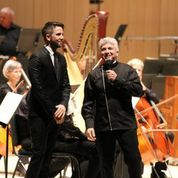|
Back
Intriguing and confounding Toronto
Roy Thomson Hall
03/07/2013 -
Tod Machover: Sparkler (*)
Owen Pallett: Violin Concerto
Krystof Maratka: Vábení: Ritual of Prehistoric Fossils of Man
Pekka Kuusisto (Violin)
The Amadeus Choir, The Elmer Iseler Singers, Lydia Adams (Choir Director), The Toronto Symphony Orchestra, Peter Oundjian (Host and Conductor), Carolyn Kuan (*) (Conductor)

O. Pallett & P. Oundjian (© Josh Clavir)
The second concert of this year’s New Creations Festival opened with Tod Machover’s Sparkler, first performed in 2001 in New York. The 13-minute piece is actually the overture for his Toy Symphony (the "toys" being inventions devised at the MIT Media Lab which he heads). The piece employs audio technologies (credited to Ben Bloomberg) which, to my ears, were fairly discreet - the main effect being that of a hidden second orchestra somewhere.
It starts off in a free and easy vein but soon becomes very driven, and it certainly gets sparkly with the use of high pitches. For quite a stretch conductor Carolyn Kuan put down her baton and cued counts to various sections of the orchestra. Mr. Machover told us there were references to 45 Beatles tunes in the piece; I listened closely and couldn’t identify a single one. (And like everyone back in the 60s I listened to the Beatles a lot. Really a lot.)
The second work, simply called Violin Concerto, was by Toronto-born Owen Pallett. This was a co-commission by the TSO and London’s Barbican Centre, where the work had its premiere a year ago with the Britten Sinfonia and soloist Pekka Kuusisto. It uses no wind instruments and hearkens back to baroque sonata form with four movements (adagio-fugue-andante-presto). However the fugue is pretty vestigial and the presto isn’t that much different from the andante.
The work teeters on the brink of being minimalist and also seems about to achieve some sort of lift-off but never quite does it. The composer’s notes state he wanted to impress upon the audience a feeling of trembling ascetic devotion. There certainly is trembling in the violinist’s repetitive phrases and, yes, it is ascetic. Pekka Kuusisto (making a welcome return to the TSO) kept a steady tone and rhythm. The composer states that the solo part could be performed without orchestra, just like a Bach sonata or partita. Maybe that should be given a try.
Concluding the evening was a work expressing composer Krystof Maratka’s idea of the prehistoric emergence of words and music: Vábení (Czech for “attraction”) for orchestra and choir (48 singers in this instance). The stage arrangement was unusual, with the choir and orchestra side-by-side. The 50-minute work is in six clearly defined movements called V, A, B, E N, and I - which spells vábení. (I rather wish the title were also a pun on the Italian va bene; no such luck.)
Members of the choir frequently employed tuning forks as there was rarely, if ever, an identifiable tuning note from the orchestra. However, the choir did little - if any - outright singing: at times they vocalized an invented language, they shouted, spoke while holding their noses, used kazoos, whistled, clapped, and stamped their feet (as did the orchestra). Peter Oundjian laboured mightily keeping the whole thing together.
This was yet another co-commission from the TSO, along with the Tansman Festival in Lodz, Poland, and a French bank’s foundation. Completed in 2011, it is dedicated to the memory of Václav Havel. It is actually the third part of a trilogy of works (and a synthesis of the earlier two) which began with an orchestral piece, Otisk (“imprint”), then Zverhora (“beast play”) for soprano and orchestra.
If you stuck with it (quite a few did not - there was a steady trickle of departures throughout) there was, by the end, a sense of some great thing groaning to be born - with a hint of ur-flamenco thrown in. (Really!) In fact, especially with the huge repeated chordal tone near the finale (just before the ethereal high-pitched ending) it seemed like a prequel to Stravinsky’s Le Sacre du printemps. The composer describes it a “a ritual experience” in his notes and I think it would work better as a ballet. A visual component would certainly assist audience acceptance; only a portion of the remaining audience participated in the applause. And I’m sure we’re all glad we weren’t alive during the paleolithic age.
Michael Johnson
|